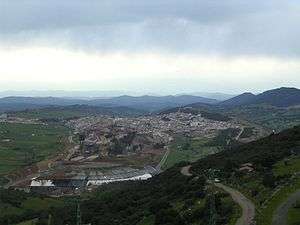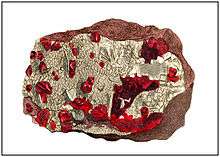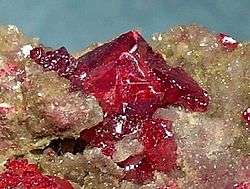Almadén
Almadén (Spanish pronunciation: [almaˈðen]) is a town and municipality in the Spanish province of Ciudad Real, within the autonomous community of Castile-La Mancha. The town is located at 4° 49' W and 38° 46' N and is 589 meters above sea level. Almadén is approximately 300 km south of Madrid in the Sierra Morena. The name Almadén is from the Arabic word المعدن al-maʻdin, meaning 'the metal.'
Almadén | |
|---|---|
 Almadén in 2007 | |
 Flag  Coat of arms | |
 Almadén Location in Spain | |
| Coordinates: 38°46′35″N 4°50′13″W | |
| Country | |
| Autonomous community | Castile-La Mancha |
| Province | Ciudad Real |
| Comarca | Almadén (comarca) |
| Government | |
| • Alcalde | Carlos Rivas Sanchez (2011) |
| Area | |
| • Total | 239.64 km2 (92.53 sq mi) |
| Elevation | 589 m (1,932 ft) |
| Population (2018)[1] | |
| • Total | 5,461 |
| • Density | 23/km2 (59/sq mi) |
| Demonym(s) | Almadenense, sa |
| Time zone | UTC+1 (CET) |
| • Summer (DST) | UTC+2 (CEST) |
| Postal code | 13400 |
| Official name | Heritage of Mercury. Almadén and Idrija |
| Type | Cultural |
| Criteria | ii, iv |
| Designated | 2012 (36th session) |
| Reference no. | 1313 |
| State Party | Spain |
| Region | Europe and North America |
Originally a Roman (then Moorish) settlement, the town was captured in 1151 by Alfonso VII and given to the Knights of the Order of Calatrava.
The mercury deposits of Almadén account for the largest quantity of liquid mercury metal produced in the world. Approximately 250,000 metric tons of mercury have been produced there in the past 2,000 years.
Due to the human toxicity of mercury and its byproducts, the mine has variously employed penal labour, slave labour, and prisoners of war over its long history. Almaden mine stopped working in 2002, due to the prohibition of mercury mining in Europe. In 2006, the mine opened to the public, who can visit the first level, 50 meters underground.
In 2012, Almaden and Idrija (Slovenian) were declared World Heritage Sites, with the nomination "Heritage of Mercury"[2]
Mining
_carretilla_en_una_galer%C3%ADa.png)
The geology of the area is characterised by volcanism. Almadén is home to the world's greatest reserves of cinnabar, a mineral associated with recent volcanic activity, from which mercury is extracted. Cinnabar was first used for pigment by the Romans. Later, the mineral was used mostly in medicine and alchemy during the Arab domination of Spain.
The Fuggers of Augsburg, two German bankers, administered the mines during the 16th and 17th centuries in return for loans to the Spanish government. Mercury became very valuable in the Americas in the mid 16th century due to the introduction of amalgamation, a process that uses mercury to extract the metals from gold and silver ore. The demand for mercury grew, and so did the town's importance as a center of mining and industry. Most of the mercury produced at this time was sent to Seville, then to the Americas.
The dangerous working conditions of the mines made it difficult for the Fuggers to find willing laborers. As the demand for mercury grew, the idea of convict labor was introduced.
Introduction of convict labor in mine
After the Fuggers failed to meet production quotas in 1566, the King of Spain agreed to send 30 prisoners to serve their sentences as laborers at Almadén. The number was increased to 40 in 1583. The prisoners, known as forzados, were selected out of criminals waiting for transport to the galleys in the jail of Toledo. Those selected usually had limited sentences and good physical abilities. Murderers and capital criminals were rarely selected, as the galleys were considered a far harsher punishment than the mines of Almadén.
The first group of forzados arrived at Almadén at the end of February 1566.
Daily life at Almadén
A steady run of complaints to the king in the 1580s led to an investigation of convict living conditions at Almadén in 1593. The investigation was conducted by royal commissioner and famous author Mateo Alemán, and was based largely on convict interviews.
The mine at Almadén provided forzados with acceptable living conditions. Each convict received daily rations of meat, bread, wine. Each year, a forzado was issued a doublet, one pair of breeches, stockings, two shirts, one pair of shoes, and a hood. Medical care was available at the infirmary, and the mine even housed its own apothecary.
Despite these good offerings, the danger of death or sickness from mercury poisoning was always present. 24% of convicts at Almadén between 1566 and 1593 died before their release dates, most often because of mercury poisoning. Nearly all prisoners experienced discomfort due to mercury exposure. Common symptoms included severe pains in any part of the body, trembling limbs, and loss of sanity. Most of the men at the furnaces died from poisoning.
Forzados were also forced to bail water out of the mines. These men escaped the dangers of mercury exposure, but suffered exhaustion on a daily basis. A group of four men had to bail out 300 buckets of water without rest. Those that could not meet this quota were whipped. Sick prisoners were not exempt from this practice.
Death was common, and the convicts wished to provide a proper burial for each of the men that died at the mine. A religious confraternity was formed, conducted by a prior who was administrator of the mine for the Fuggers. The prior also chose devout convicts to serve as officials. Mass was held on Sundays and feast days, and non-attendance was punishable by fine.
Slave labor
North African slaves were purchased directly from slaveholders to work alongside the convicts. These slaves were often much cheaper than others on the market at the time, and by 1613, slaves outnumbered forzados by a two-to-one ratio.
1645 to present


In 1645, the Fugger concession was cancelled and the mines were taken over by the state, to be managed by the royal government. All capital criminals were to be sent to Almadén by court order in 1749, but the mine simply could not accommodate all of them. The act was cancelled in 1751.
Two disastrous fires occurred in 1775 that were blamed on the forzados.
Safer mining technology was introduced in the last quarter of the 18th century, and free laborers began to take interest in the mine again. By the end of the century, free workers had replaced most of the slave labor. The penal establishment at Almadén was closed in 1801.
In 1835, during the First Carlist War, the mine was leased indefinitely to the Rothschild Bank. The price paid was high, but one of the Rothschild family firms had previously purchased the quicksilver mine in Idrija (now in Slovenia) from Austria; thus the firm had a monopoly on quicksilver (until discovery of New Almaden in California). Volume was expanded and the metal sold at a substantial markup returning a substantial profit to both Spain and the firm. Spain reclaimed the mine in 1863.[3]
In 1916, a special council was created to operate the mines, introducing new technology and safety improvements. A record production of 82,000 mercury flasks was reached in 1941, just after the Spanish Civil War, using prisoners of war as forced labor.[4] This amount is comparable to the 3.000.000 kg that were produced by China in 2018.[5] The price for mercury decreased from a peak of US$571 in 1965 to US$121 in 1976 making economic planning difficult. In 1981, the Spanish government created the company Minas de Almadén y Arrayanes to operate the mine. In 2000, the mines closed due to the fall of the price of mercury on the international market, caused by falling demand. However, Almadén still has one of the world's largest mercury resources.
Almadén is now a World Heritage Site, Heritage of Mercury. Almadén and Idrija. A museum has been built, including visit to the mines (areas from 16th to 20th century).
See also
- Huancavelica, the other major source of mercury in the Spanish Empire
- The New Almaden Quicksilver Mine in Santa Clara County, California
External links
| Wikimedia Commons has media related to Almadén. |
References
- Municipal Register of Spain 2018. National Statistics Institute.
- Centre, UNESCO World Heritage. "Heritage of Mercury. Almadén and Idrija". whc.unesco.org. Retrieved 2018-04-27.
- Egon Caesar Corti; translated by Brian; Beatrix Lunn (1928). The Reign of the House of Rothschild (hardcover) (1st ed.). New York: Cosmopolitian Book Corporation. pp. 110–112, 150.
- Miguel Calvo Rebollar (1928). Minerales y Minas de España, Vol.2 Sulfuros y sulfosales (hardcover) (1st ed.). Vitoria, Alava (Spain): Museo de Ciencias Naturales de Alava. pp. 356–359.
- World mercury production 2017-2018
A. Hernández; M. Jébrak; P. Higueras; R. Oyarzun; D. Morata; J. Munhá (1999). "The Almadén mercury mining district, Spain". Mineralium Deposita. 34 (5–6): 539–548. doi:10.1007/s001260050219. hdl:10578/1287.